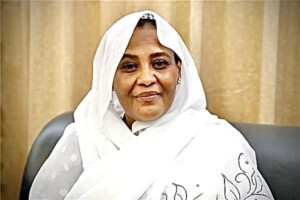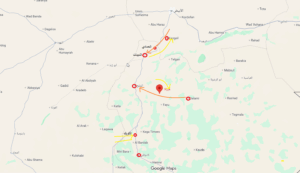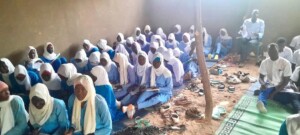Sudan timeline October-December 2021: Democratic transition under siege, foreign finance cut as military sizes power
The last quarter of 2021 was a turbulent one for Sudan, the aftershocks of which continue until now. In October, the civilian sections of the government were divided over which course to follow. On October 25, Sudan’s military seized power in a coup d’état, placing civilian Prime Minister Abdullah Hamdok under house arrest. In western Sudan, insecurity increased and in the eastern part of the country sea ports and roads were blocked by the High Council of Beja Nazirs who demand the cancellation of the Eastern Sudan protocol of the October 2020 Juba Peace Agreement.
 Cartoon by Omar Dafallah (RD)
Cartoon by Omar Dafallah (RD)
The last quarter of 2021 was a turbulent one for Sudan, the aftershocks of which continue until now. In October, the civilian sections of the government were divided over which course to follow. On October 25, Sudan’s military seized power in a coup d’état, placing civilian Prime Minister Abdallah Hamdok under house arrest. In western Sudan, insecurity increased and in the eastern part of the country sea ports and roads were blocked by the High Council of Beja Nazirs who demand the cancellation of the Eastern Sudan protocol of the October 2020 Juba Peace Agreement.
The military coup immediately resulted in a massive campaign of pro-democracy protests and civil disobedience organised by the Resistance Committees. This was met by a violent crackdown by the coup forces, which has seen scores of civilians killed, hundreds injured, and many more detained. Foreign aid donors immediately turned off the financial taps.
On November 21, in an attempt to break the post-coup impasse, Sudan’s Hamdok is reinstated after an accord with the military junta, but opposition forces reject the deal.
This brief political respite cannot withstand the critical mass of public dissent, coupled with violent government response, and as the year draws to a close, Hamdok’s position becomes increasingly precarious, resulting in his resignation during the first days of 2022.
Sudan timeline, October – December 2021
October: On October 25, Sudan’s military seized power in a coup d’état, placing civilian Prime Minister Abdullah Hamdok under house arrest amid a chorus of condemnation from at home and abroad.
October 2: The USA calls on the parties to the government in Sudan to reach a consensus on the date for the transfer of the presidency of the Sovereignty Council to civilians. More delay may hamper major US support.
October 3: On the Juba Peace Agreement’s first anniversary, the Sudan Troika congratulates the Sudanese. It, however, is “deeply concerned” about the delayed implementation of the agreement. Twelve young Darfuri women and girls from the Kounongou refugee camp in eastern Chad are raped by cattle herders.
October 4: The deadline for the Sudanese government to respond to the demands of the eastern Sudanese High Council of Beja Nazirs and Independent Chieftains and end the Eastern Sudan Track protocol of the Juba Peace Agreement ends this evening. Beja have closed ports and highways in eastern Sudan to protest the agreement. Four suspects and a security agent are killed during a raid on a terrorist cell in Khartoum. Gen Abdelfattah El Burhan, Head of the Sovereignty Council and Commander of the Sudan Armed Forces, urges the implementation of security arrangements in Darfur.
October 5: Sudan’s Empowerment Removal Committee* (ERC) protests the High Court’s decision to nullify the committees’ dismissal of judicial employees affiliated with the former regime of Omar Al Bashir. Several initiatives have been launched to defuse tensions between the civilian and military components of the Sudanese government. The Beja Nazirs Council sticks to its demands and continues its protests.

October 6: Displaced people in Darfur express their dissatisfaction with “the failure” of Sudan’s transitional government to implement the provisions of the Juba Peace Agreement that have not been implemented “by even one percent so far”. Jabra neighbourhood in southern Khartoum again witnesses heavy deployment of security forces searching the neighbourhood for Islamic terrorists. The Ministry of Health receives its first shipment of Pfizer COVID-19 vaccines. PM Hamdok briefs envoys and FFC on his talks with the military.
October 7: Two gold miners are killed and several others are injured in River Nile state when government forces shoot at a miners’ protest against job losses. Sudan and South Sudan sign a Memorandum of Understanding in the South Sudanese capital Juba on water management and flood prevention.
October 8: Seven people are killed and ten others injured in an armed robbery west of Delling in South Kordofan.
October 9: At least seven people are killed in attacks on villages in Darfur and South Kordofan. The North Darfur Ministry of Health reports that cases of dengue fever and hepatitis E have emerged in the state.
October 11: El Burhan stresses that there is no solution to the current political problems except by dissolving the government. The Sentry, an initiative that investigates ‘dirty money, advises Sudan to ‘prioritise banking reform’. Finance Minister Jibril Ibrahim lauds efforts of the Forces for Freedom and Change (FFC), the driving force behind the Sudanese uprising, to unify it ranks. The Jurists Group for the Protection of the Revolution and the Democratic Transition is launched following the High Court decision to cancel the decisions of the ERC.
October 13: Sudan’s Revolutionary Awakening Council (RAC) of former Janjaweed leader Musa Hilal announces its withdrawal from the Declaration of Freedom and Change, signed in early 2019. The High Court Chamber decides to return more senior prosecutors dismissed by the ERC because of their ties with the former regime. Sudan’s Ministry of Foreign Affairs says it is not responsible for any (foreign) visits or meetings by its officials after Gen Mohamed ‘Hemeti’ Dagalo, Vice-President of the Sovereignty Council and Commander of the paramilitary Rapid Support Forces (RSF) and the director of the Sudanese Defence Industries visit Israel.
October 14: Facebook removes accounts linked to Sudan’s paramilitary RSF. Sudanese lawyers call for a civilian government.
October 15: PM Hamdok says that Sudan is facing its most dangerous crisis. The conflict between the military and civilian sections of the Sudanese government escalates after the General Intelligence Service (GIS) issued a travel ban for 11 leading members of the ERC. Economist Hasan Bashir warns for the negative effects of the political tensions on the economy. Armed robberies and killings continue in South Kordofan and Darfur.
October 16: A Charter for the Unity of the FFC is signed in Khartoum.
October 17: North Darfur students protest soaring bread prices in El Fasher.
October 18: Public anger erupts as North Darfur attacks leave two dead and two others injured. El Burhan tells a British political delegation that Sudan remains committed to the process to democracy. The Council of Ministers forms a seven-member committee headed by PM Hamdok to contain the acute political crisis between the various government sections. The FFC-Central Council lauds Hamdok’s initiative to resolve crisis.
October 19: A Sudanese study reveals that 74 protestors died between the June 3, 2019 ‘Khartoum sit-in massacre’ and June 10, 2019. A State of Emergency is declared in North Darfur after repeated attacks on farmers during the harvest season. Road and port closures intensify in eastern Sudan.
October 20: Sudan’s government has contacted the Beja nazirs to resolve the Eastern Sudan Track disputes.
October 21: Sudan cities and towns brace for Marches of the Millions today. Protesters are injured, some severely, as security forces use teargas and bullets to disperse protests in which hundreds of thousands of people take part.
October 24: The police fire tear gas to clear barricades by alleged supporters of the ousted dictator in Khartoum.
October 25: Sudan’s military seizes power in a dawn coup, and detains PM Hamdok and a number of officials. At least four people are killed as government forces fire on anti-coup demonstrators. The international world condemns Sudan’s military coup. UN Secretary-General António Guterres calls for the immediate release of PM Hamdok and other officials. The USA suspends promised aid.
October 26: Mass protests against the coup enter their second day. The EU decries the coup as ‘attempt to undermine Sudan’s transition towards democracy’. Journalist Fayez Seleik is detained after criticising the coup. The UN Security Council holds an emergency meeting on Sudan. The African Union (AU) suspends Sudan‘s membership until the country returns to civilian-led authority.
October 27: Coup leader Lt Gen Abdelfattah El Burhan meets with UNITAMS Head Volker Perthes. The World Bank announces that it suspends aid to Sudan after the coup.
October 28: Sudan remains in the grip of the military coup with a continuation of detentions and the internet remaining closed. Anti-coup protests continue in Khartoum and other states, while main roads and bridges in the capital remain blocked by military forces. Reportedly 11 protesters have been killed and 150 others injured since the coup. The putschists continue their detention campaign.
October 29: The UN Security Council and the Friends of Sudan group both demand end to coup and the release of all detainees. Sudanese lawyers and activists call on Gen El Burhan to reverse the coup.
October 30: A protester is killed and hundreds are wounded as security forces use heavy ammunition to crack down on new Marches of the Millions.
October 31: A cautious calm descends on Khartoum as shops, companies, and other institutions remain closed in protest against the coup. The Central Committee of Sudan Doctors announces that the number of victims of the anti-coup demonstrations has risen to at least 12 dead and hundreds wounded. Attacks on farmers in North Darfur leave six dead.
November: The campaign of civil disobedience continues, with increasingly violent response from coup forces.
November 1: Civil disobedience actions against the military coup continue. Sudanese lawyers, activists call on Gen El Burhan to reverse the coup, while eastern Sudanese leaders seem to welcome the putsch. Internet blackout continues, while mobile phone service is restored in the country. The number of victims of the demonstrations against the military coup since October 25 has risen to at least 12 dead and hundreds wounded.
November 2: The FFC declare categorically that “there will be no dialogue or negotiations with the putschists“. Attacks on farmers in North Darfur leave six dead.

November 3: Dozens of people, including politicians, government officials, lawyers and other professionals are arbitrarily detained in an ongoing campaign against revolutionaries across Sudan by government forces since the military seized power on October 25. Political forces in eastern Sudan consider the coup d’état “an attempt to commit national suicide“.
November 4: Saudi Arabia, the UAE, the USA, and the UK (the ‘QUAD’ for Sudan) affirm their stance with the people of Sudan in their aspirations for a democratic nation. The South Sudan mediation team sees ‘some progress’ as coup leader El Burhan pledges to release detainees. Rebel leader Abdelwahid El Nur calls for a ‘popular revolution’ to overthrow the coup. US think-tank The Sentry states that the coup is a ‘result of warped incentive structures that trace back to the Al Bashir era’.
November 5: The UN The Office for the Coordination of Humanitarian Affairs (OCHA) in Sudan reports rising commodity prices as the situation in Sudan remains ‘unpredictable’.
November 7: US resolution calls on Secretary of State to consider ‘targeted sanctions‘ against the Sudanese coup leaders. The University of Khartoum suspends studies in rejection of the military coup. Reports about more detentions in Sudan, while civil disobedience actions and anti-coup protests continue.
November 8: El Gezira University and the Red Sea University suspend studies ‘to preserve the safety of the students and employees’.
November 9: A court in Khartoum orders Sudan’s main telecoms providers to restore access to the internet which was shut down during the coup on October 25. Insecurity is growing in the Nuba Mountains. Darfur displaced say that gunmen in the region see the military coup as a license to resume attacks. East Darfur hospital refuses to treat political detainees with COVID-19.

November 11: Coup leader El Burhan restores the (restructured) Sovereignty Council. Four more Sudan universities suspend studies indefinitely in response to the current instability in the country following the military coup of October 25.
November 12: El Burhan announcement about the Sovereignty Council triggers large street protests in Khartoum. Groups of gunmen attack villages in North Darfur, kill people and destroy hundreds of homes.
November 13: Tens of thousands of Sudanese join the Marches of the Millions against the military coup. The Central Committee of Sudan Doctors reported five protesters killed in the capital. The US Embassy in Khartoum condemns the excessive use of force.
November 15: More journalists, activists, protesters, including minors, held in Sudan. The international community voices its condemnation of the use of excessive force against demonstrators. The internet blackout persists despite Khartoum court orders.
November 16: The death toll in Sudan November 13 protests rises to eight as a girl (13) was shot in the head. Government forces pre-emptively detain activists ahead of November 17 protest marches.
November 17: At least five people are shot dead as government forces fire on anti-coup demonstrations in Khartoum. Detentions continue in the country. Lawyers report beatings and torture. Press groups hold a vigil in Khartoum, more journalists are detained. Doctors report new waves of COVID-19, haemorrhagic fever in Sudan as healthcare fails.
November 18: USA, Norway, Germany, UN call for return to democratic transition in Sudan, while heavy military presence in Khartoum has ‘turned the city into a military barracks‘. 15 protesters are confirmed dead in November 17 protests in the capital.
November 19: More journalists detained by military forces in Khartoum. The FFC-Central Council speaks about a new massacre during the March of Millions on November 17. The military junta plans to reinstate PM Abdallah Hamdok. Gunmen plunder the office of Médicins Sans Frontières/Doctors Without Borders (MSF) in Ed Daein, capital of East Darfur.
November 21: Sudan’s PM Hamdok is reinstated after an accord with the military junta, but opposition forces reject the deal. According to Hamdok the agreement would “helps to break the internal and external impasse” and save “the blood of more Sudanese”. The UN Integrated Transition Assistance Mission in Sudan (UNITAMS) welcomes the agreement.
November 22: At least 21 people died in attacks on villagers and nomads in Jebel Moon, West Darfur, during the past days. Thousands of villagers fled to eastern Chad after their homes burned to ashes. Defiant mass marches calling for a civilian government continue across Sudan.
November 23: 11 Ministers resign as ‘Hamdok agreement legitimises military coup regime’. Social media are still blocked in the country. The military junta releases select detainees, many still imprisoned.
November 25: PM Hamdok orders the police to release all political detainees. He said that he will resign if the Sudanese see that the political agreement, signed in Khartoum on Sunday with coup leader Gen Abdelfattah El Burhan, does not serve their interests. The number of people killed since the coup on October 25, rises to 42.
November 26: Resistance Committee members in Sennar beaten and humiliated as detentions continue.

resulting in Hamdok’s resignation (Photo: SUNA)
November 28: Hamdok issues directive relieving the country’s police chief and his deputy from their positions. The Director of Military Intelligence, and the Director of the General Intelligence Service were dismissed as well.
November 29: Another batch of activists, politicians, and civil society leaders, held after the October 25 coup, is released, however several remain in detention. At least 20 members of the Sudanese Armed Forces (SAF) die during a clash with Ethiopian army forces and militiamen in eastern El Gedaref.
November 30: Several demonstrators are injured in the March of Millions today. Insecurity remains rampant in the Nuba Mountains.
December: Excessive violence against demonstrators continues, rapes are reported, as the attempts of coup forces to quell the public uprisings become increasingly harsh. In Darfur, lawlessness prevails as the former UNAMID base, as well as a warehouse of the UN World Food Programme, are looted in El Fasher.
December 1: Khartoum healthcare ‘faces imminent collapse’, Sudan states announce COVID-19 curbs. A group of American officials appeal to President Biden for urgent action on Sudan’s political crisis. PM Hamdok assigns undersecretaries to run the 20 federal ministries until new, technocrat ministers have been selected.

December 2: Sudan doctors count 98 injured from tear gas and stun grenades during November 30 demonstrations. El Fashaga in El Gedaref witnesses renewed border clashes between Sudanese army troops and Ethiopian forces.
December 3: UN, UNITAMS push for democratic transition in Sudan. Tribal clashes break out in the Nuba Mountains, killing dozens
December 6: Kereinik camp for displaced people burns in deadly West Darfur attack. Many protesters are injured, detained in renewed demonstrations across Sudan.
December 7: At least 15 people die in tribal clashes in West Kordofan. The initial death toll following an attack by armed men on Kereinik in West Darfur has risen to 48. The head of UNITAMS meets with members of Khartoum Resistance Committees to share their views on the political situation. A Russian defence delegation will visit Sudan to renew ties with Khartoum.
December 8: UNITAMS head Volker Perthes to report to UN Security Council on Sudan.
December 9: Renewed attacks on West and North Darfur villages leave 25 dead, thousands displaced. Gen El Burhan warns foreign diplomats against interference in Sudan affairs. Sudanese analyst predicts ‘absolute violence to suppress the protest movement’ in the country.
December 10: Schools are closed in eastern Sudan’s El Gedaref as COVID-19 cases rise.
December 13: Federal Governance Minister terminates the services of the acting state governors appointed by Gen Abdelfattah El Burhan following the coup. At least 200 now confirmed dead in West Darfur attacks.
December 14: Tens of thousands of Sudanese again demonstrate against military rule.
December 15: The International Committee of the Red Cross (ICRC) in Sudan to train Rapid Support Forces on humanitarian law. A delegation from the International Criminal Court (ICC) in The Hague arrives in Khartoum to discuss the extradition of ousted President Omar Al Bashir.

December 16: Hamdok says that the delay in the formation of a new Sudanese government is caused by ongoing discussions between various political forces concerning a national charter. The High Council of Beja Nazirs will resume its protests against the eastern Sudan peace protocol.
December 17: The Vice President of the Sovereignty Council, Lt Gen Mohamed ‘Hemeti’ Dagalo, announces the suspension of the Eastern Sudan Track protocol that is part of the Juba Peace Agreement, until a new accord has been reached. Saudi Arabia, the UAE, the USA, and the UK (the ‘QUAD’ for Sudan) are ‘encouraged’ by the reinstatement of Hamdok as Prime Minister of Sudan. According to the Deutsche Welle, security forces and paramilitaries confronted Sudanese demonstrators with anti-aircraft weapons.
December 18: Groups of gunmen continue to torch villages in North Darfur.
December 19: International organisations and prominent individuals assert that “the USA has a critical role to play in supporting the aspirations of the Sudanese people”. USA and Norway urge Sudanese coup leaders to recommit to civilian-led democratic transition. Marches of the Millions begin across Sudan to mark the anniversary of the December 2018 revolution. Demonstrators in Khartoum reach the Republican Palace in the centre of the city.
December 21: At least one dead, two raped, and 300+ injured in the December 19 protest marches. The UN High Commissioner for Human Rights urges “a thorough investigation“ after reports of sexual violence by security forces during demonstrations in Khartoum on December 19.
December 22: The Central Committee of Sudanese Doctors say that the real Darfur violence toll is hard to tally. The FFC state that a ‘united popular front’ is needed to defeat the Sudan junta.
December 23: PM Abdallah Hamdok says he is ‘deeply frustrated’ by Sudan’s political crisis, and considers submitting his resignation. The international community condemns the rapes by security forces during the December 19 March of Millions in Khartoum. According to the Sudanese Journalists Network, December 19 witnessed the highest rate of violence in one day for journalists and media professionals.

December 25: Sudan protestors again face tear gas, stun grenades.
December 26: One dead as newly transferred North Darfur UNAMID base is looted. The acting head of the National Umma Party (NUP), Maj Gen Fadul Burma, meets with El Burhan and presents a road map for a way out of political impasse in the country.
December 27: Sudan’s inflation rate continues to decline, food insecurity however increases. The Central Committee of Sudan Doctors reports that at least 235 demonstrators were injured on December 25. El Tijani Sese, former head of the Darfur Regional Authority, launches the National Movement Forces alliance in Khartoum.

December 28: Security forces embark on a detention campaign in Khartoum and other states, after Gen El Burhan has given the General Intelligence Service (GIS) the authority to detain people again. A warehouse of the UN World Food Programme (WFP) in El Fasher, capital of North Darfur, is plundered.
December 29: The Darfur Bar Association reports that it has received 30 complaints of sexual harassment, including 16 complaints of rape, allegedly perpetrated by security forces in Khartoum on December 25. A prominent Sudanese lawyer tells Radio Dabanga that the Sovereignty Council has no right to call for general elections. He welcomed the position papers on a way out for the current political crisis presented by the two FFC factions as well as the Umma Party roadmap.
December 30: Government forces fire live ammunition and tear gas on demonstrators in Khartoum, killing five.
December 31: The UN World Food Programme (WFP) suspends operations across North Darfur, following the looting of three of its warehouses in the state capital El Fasher.
* The full name is the Committee for Dismantling the June 30 1989 Regime, Removal of Empowerment and Corruption, and Recovering Public Funds. It was established by the government of Abdallah Hamdok in November 2019 with the aim to purge Sudan of the remnants of the ousted regime of dictator Omar Al Bashir (1989-2019). Empowerment (tamkin) is the term with which the Al Bashir government supported its affiliates by granting them far-going privileges, including government functions, the setting-up of various companies, and tax exemptions.
** A nazir is a state-appointed administrative chief of a tribe or clan, according to the Native Administration system in Sudan introduced by the British colonial authorities in the first quarter of the 20th century.
Previous timelines:
Sudan timeline April-June 2020: Covid-19 marks all aspects of life, inflation soars
Sudan timeline January-March 2020: Little relief to the country’s economic, security woes
Sudan timeline October-December 2019: Interim government put to the test
Sudan timeline July-September 2019: Turbulent transformation from tyranny











 and then
and then